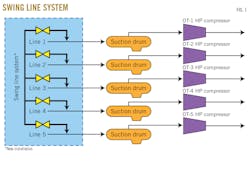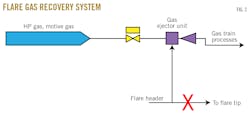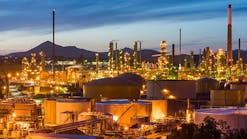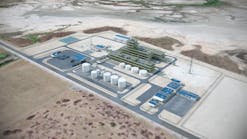Mazen A. Al-Juaid
Mohammed F. Muaibed
Kamarul A. Amminudin
Saudi Aramco
Dhahran
In early 2018, Saudi Aramco undertook two separate projects to install a new gas compressor swing line system and a flare gas recovery system at its 1.5-million b/d Khurais Central Processing Facility (KhCPF) in Saudi Arabia as part of the company’s ongoing program to enhance efficiency and environmental emission performance across operations.
Completed in 2019, the projects have greatly contributed to achieving environmental emission goals. At the same time, the projects—especially the swing line system—have offered power-saving incentives by incorporating a load management operating philosophy that guarantees optimum operation of individual gas compressors. The projects also enhanced reliability of both the compressor fleet and the flare system, improving operating flexibility. Alongside these benefits, recovered gas can now be monetized, generating additional revenue. This article examines the KhCPF team’s experience in developing, executing, and implementing the two projects.
Processing at KhCPF
Commissioned in 2009, KhCPF can process 1.5 million b/d of Arab Light crude, associated gas, and condensate from three major fields: Khurais, Abu Jiffan, and Mazalij. The plant also injects water to sustain reservoir pressure for these fields.
Crude oil from the fields is first processed at the gas-oil separation plant (GOSP), producing stabilized crude through a series of separation systems.
Stabilized crude is then sent to the terminals for export by pipeline. Gas separated from the GOSP is compressed and sent to the Khurais gas trains, where it receives dehydration, refrigeration, and stripping. Gas product from the plants is piped as sour gas to another gas plant for sweetening. Condensate recovered as NGL from the stripper bottom is sent to another gas fractionation train.
To support these processes, Saudi Aramco has a utility system that provides steam and other utilities. All power is supplied by a contracted power company.
Project rationale
While Aramco has long emphasized environmental conservation in its operations, this focus was strengthened by Saudi Arabia’s commitment to the 2015 Paris Agreement on Climate Change. With Aramco’s commitment towards meeting its national objective considered a patriotic cause, along with its obligations under the Oil & Gas Climate Initiative (OGCI), the company is proactively minimizing its environmental impact.
In the past, KhCPF implemented best practices for tackling environmental emissions indirectly, mainly by striving for energy efficiency and conservation gains (OGJ, Dec. 4, 2014, p. 76). While adopting these energy best practices continue to bring benefits to this day, as part of its OGCI obligation, Aramco began implementing other initiatives to attain continuous improvement in environmental emission performance.
Project execution
Development, installation, and commissioning of the high-pressure (HP) gas compressor swing line system and flare gas recovery system were executed based on these environmental principles.
HP gas compressor swing line system. Deployment of the HP gas compressor swing line system involved construction of additional flow lines to accommodate additional routing of streams to other compressors. The system connects the suctions of HP compressors on GOSPs 1, 2, 3, 4, and 5 to allow load sharing operation, in which gas from these GOSPs is split among the HP compressors, with the objective of maximizing operating loads in each gas compressor. In doing so, the last compressor can be shut down for as long as the capacity of the other compressors is still adequate to accommodate the extra gas from the shutdown compressor.
Fig. 1 shows a schematic of the swing lines of the new HP gas compressor network; basically additional flow lines to accommodate the additional routing of streams to other compressors feeding KhCPF oil trains (OT).
The Khurais Producing Department (KhPD) team developed the original idea for the HP gas compressor swing line project during a routine process and energy optimization assessment of the facility, identifying it as an opportunity to optimize power consumption of the HP gas compressor network.
KhPD carried out an engineering assessment to come up with preliminary design and economic incentives. During this assessment, the team deliberated the pros and cons of various possible swing line configurations, from the offtake points to the receiving points, referring to company engineering standards, especially with regard to the piping material, pipe routing, and required pipe size.
Once management approved and funding was secured, the project entered the detailed design phase, in which an engineering, procurement, and construction (EPC) contractor was selected for this project. Process data like feed composition to the compressor, typical operating regimes, and the current as-built engineering drawings—including process flow diagram, piping-process and instrumentation diagram, and isometric drawings—were provided.
The EPC contractor took 6 months to come up with a complete design package of the proposed swing line configuration. At this stage, the team assumed a due-diligence role on the contractor design work, to ensure compliance with the relevant company engineering standards. The EPC contractor reviewed the package with the team before the construction began, with safety given the utmost priority, both during this stage and installation.
Ensuring safety in the commissioning and operation of the swing line system—especially hooking it up to the existing facilities—proved difficult. Governed by Aramco’s strict safety policy, the installation underwent extensive safety review right from the design stage. The most critical review was the HAZOP assessment, which was done during preparation of the design package. The team from the loss-prevention department and engineering subject matter experts participated in discussions on the various possible hazard scenarios. Dynamic simulation was also performed to see the impact of the swing line system during the switch over. Of special interest was identifying the pressure transient profile pattern throughout the system to ensure the integrity of the lines. Similarly, change documentation was prepared in detail, as implementation involved multiple tie-ins with existing facilities aimed at smooth integration without adverse impact.
During construction, the team conducted a safety briefing for contractor employees, with a focus on appropriate use of personal protective equipment (PPE), ladders, and hydrogen sulfide (H2S) indicators. The installation, which was made on an elevated structure, together with extensive welding requirement for the piping tie-in, mandated the use of PPE and strict safety procedures. Installation occurred during a total plant shutdown. Various types of work permits were issued, mainly hot work permits, to ensure worker safety during construction. On the compressor fleet itself, reassessment of the compressor surging points and compressor control schemes to accommodate the new swing line system was completed. This included retuning control parameters and revising surge control line set points.
Flare gas recovery system. In conjunction with the swing line project, the team presented an initiative to recover flared gas amid anticipation of higher volumes from the site in the future. This project was undertaken as a proactive strategy in meeting Saudi Arabia’s tighter environmental emission regulations. As in the swing line project, development required dedicated work among the team and commitment to come up with a cost-effective flare gas recovery system. The focus was to recover flared gas from both high-pressure (HP) and low-pressure (LP) flare systems.
The system uses gas ejector technology by extracting the flared gas from the HP and LP flare headers using motive gas from the compressor discharge that boosts the pressure of the flared gas before returning it to the compressor’s suction header for further downstream processing. With such a closed loop operation, flaring is greatly minimized or eliminated altogether.
Fig. 2 shows a diagram of the flare gas recovery system.
An engineering assessment was performed to screen preliminary designs and work out the economic incentives for this project. During this evaluation, the team deliberated various possible flare gas recovery technologies, inviting key flare gas recovery vendors to the facility to share their respective offerings in detail. These included liquid ring compressor systems, gas ejectors, and even conventional compressor systems or blowers. Selection was made based on economic merits, constructability on the existing sites, and the unit’s reliability. Company engineering standards were referred to in developing the preliminary design based on the selected technology from the vendor. Once the concept was approved, the project entered the detailed design phase and an EPC contractor was selected.
The selected flare gas recovery vendor provided its design package, which was integrated with the EPC package. As in the swing line project, the EPC contractor reviewed the package with the team before construction began.
Both the swing line and flare gas recovery system projects were executed and commissioned about the same time, with an excellent safety record, within the budget and on schedule.
Post-installation assessment
Once commissioned, the operation team took control of the systems and any teething problems were addressed. The engineering validated performance of both the swing line and flare gas recovery systems after they reached stable operations.
Following are the outcomes of the assessment:
- Environmental benefits. The major driver for these projects was to preserve the environment. The flare gas recovery unit has met this objective by recovering purge and leak gas that would otherwise be flared. Flaring was reduced by 95% between 2018 (pre-installation) and 2019 (post-installation).
The performance audit also revealed a project payback period of less than 1 year, well within the company’s standard criteria. Recovered gas also can be monetized by further processing to produce sales gas, generating additional revenue.
Selecting gas ejector technology as opposed to conventional technology, such as either a compressor or blower, yielded energy benefits as well. Instead of using electrical power to drive the flare gas recovery system, the gas ejector uses motive HP gas from the adjacent compressor to drive the ejector, a positive for energy conservation. The project yielded another maintenance benefit: extended flare tip life.
Installation of the swing line system also had a positive environmental impact, avoiding having gas flared as the result of an HP gas compressor trip. Instead, this otherwise flared gas is accommodated by other HP gas compressors. During one trip incident on a compressor, the team managed to divert the otherwise flared gas to the remaining operating compressors, while operation and maintenance personnel fixed the downed compressor.
- Power optimization benefits. With operational flexibility greatly improved, installation of the swing line system contributed to large power savings. A recent audit showed power savings of up to 20% as a result of shutting down one unnecessary compressor.
- Compressor network reliability improvement. The swing line system enables KhCPF to ensure that individual compressors are operated at the maximum load possible, maintaining higher performance efficiency. When the system is in use, there is at least one spare compressor sitting idle. Having the spare compressor idling for long, however, is not recommended. Instead, the swing line makes it possible to rotate which next compressor is to be idled.
Acknowledgement
The authors would like to extend their appreciation to Saudi Aramco, especially the project management team and KhPD, for providing the cooperation, encouragement, and resources required to complete and publish this study.
The authors
Mazen Al-Juaid ([email protected]) heads Saudi Aramco’s Khurais Producing Projects Development Division. He has worked at various organizations within Aramco, including producing, refining, production planning, and project management. Before joining Aramco, he worked at the Saudi Industrial Development Fund. Mazen holds a BS (2001) in chemical engineering and an MS (2010) in construction engineering and management from King Fahd University of Petroleum and Minerals, Saudi Arabia. He also earned the Project Management Professional certification in 2009 from the Project Management Institute (PMI).
Mohammed F. Muaibed ([email protected]) currently leads the strategy and portfolio management team within the Saudi Aramco upstream organization. After joining Aramco in 2001 as a rotating equipment engineer, he later moved on to leadership and project management functions in several Aramco organizations. He holds a BS (2001) in mechanical engineering from King Fahd University of Petroleum and Minerals, Saudi Arabia. He is also a certified Lean Six Sigma Green Belt following successful implementation of the initiatives mentioned in this article.
Kamarul A. Amminudin ([email protected]) is a senior operation engineer in Saudi Aramco’s Khurais Producing Department, where he leads various process and energy optimization initiatives. He holds a PhD in process integration from the University of Manchester Institute of Science and Technology, Manchester, UK. He is a registered UK chartered engineer and a fellow of Institution of Chemical Engineers, UK. He also holds two US patents and two pending US patents to his credit.



